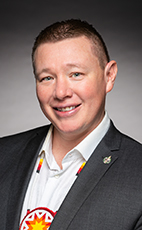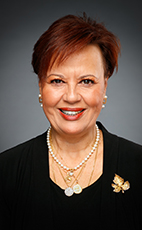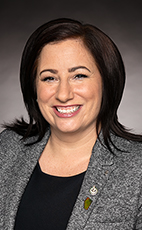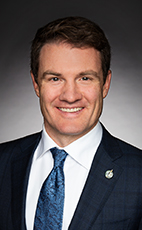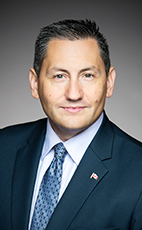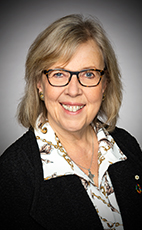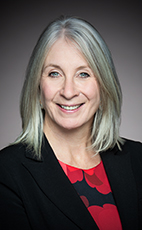44th Parl. 1st Sess.
May 2, 2023 10:00AM
- May/2/23 9:48:08 p.m.
- Watch
Madam Chair, I would like to thank the member for Saanich—Gulf Islands for her commitment to this file.
I believe the red dress has become a symbol of political action as well as a symbol of creating awareness. We have seen indigenous communities from coast to coast to coast have their own different displays, many artistic, in their cultural centres or in music videos. All of them have the same idea that we need to do more.
We need to create more awareness. We need to create a society that understands we need to do more for missing and murdered indigenous women, for missing and murdered indigenous people all across Canada. Until we get to that awareness where people understand there is a historic problem we are trying to remedy, we need to continue to promote the red dress as a symbol and as a political statement everywhere across Canada.
152 words
All Topics
- Hear!
- Rabble!
- add
- star_border
- share
- May/2/23 9:49:08 p.m.
- Watch
Madam Chair, I thank my colleague for his speech. What stands out for me tonight, as a member of the Standing Committee on the Status of Women, is the number of times we have talked about this issue and the number of reports that have been completed on missing and murdered indigenous women and girls. How many times have we talked about the recommendations and the reports?
We are here tonight. I was here last year, too. We are still talking about missing and murdered indigenous women and girls in 2023. My colleagues on the Standing Committee on the Status of Women will agree with me. We are unfortunately, still, in 2023, talking about this issue, noting that indigenous women and girls are disproportionately affected—
126 words
All Topics
- Hear!
- Rabble!
- add
- star_border
- share
- May/2/23 9:50:02 p.m.
- Watch
I have to give the parliamentary secretary 15 seconds to answer.
11 words
- Hear!
- Rabble!
- add
- star_border
- share
- May/2/23 9:50:09 p.m.
- Watch
Madam Chair, I think we need to continue talking about this until we figure out a solution. Keep in mind that this is not something we are just talking about in Canada. I just came back from the United Nations where they were having this very same discussion in the United States, New Zealand and Australia and asking how they can all do better. They are coming to us for the steps we have taken on having a public inquiry. This is a greater global issue that comes with indigenous people and colonization. We need to fix it and we need to continue talking until we have—
108 words
All Topics
- Hear!
- Rabble!
- add
- star_border
- share
- May/2/23 9:50:38 p.m.
- Watch
We have to resume debate.
The hon. member for Lakeland.
10 words
- Hear!
- Rabble!
- add
- star_border
- share
- May/2/23 9:50:45 p.m.
- Watch
Madam Chair, I represent nine indigenous communities, first nations and Métis settlements across the 35,000 square kilometres of Lakeland, among 52 municipalities of different sizes, mostly small communities in rural areas.
Near St. Paul, Canada's first indigenous-owned and directed Blue Quills University, once a residential school, stands as a reminder of successive government policies that interfered in families, broke the bonds between children and parents, extended relatives and communities, involved barbaric abuse and led to children becoming adults cut off from their cultural identity and belonging. My own family background is one with a social services-caused family gap from Ojibway relatives. That, among other government policies and laws that prevented indigenous people from being in control of their own lives, caused trauma that has impacted generations and the reality of disproportionate socio-economic, domestic violence and crime-related challenges experienced by indigenous people in Canada.
Local indigenous people turned more than four decades of hurt into hope, and Blue Quills now offers jobs training and degrees in first nations languages, focuses on restoring indigenous languages and cultures to contribute to intergenerational healing, and offers all Canadians information about residential schools.
Today, Blue Quills, like on the grounds of so many other former residential schools across the country, is also identifying the remains of children who died there and were never returned to their families.
Indigenous women and girls are still being taken. They are going missing from their families and communities in Canada.
The facts are brutal. Indigenous women and girls are disproportionately affected by all forms of violence. At a parliamentary committee, experts testified that 52% of human trafficking victims are indigenous. Horrifyingly, the average age of exploitation of an indigenous girl is just 12 years old.
Many reports show that indigenous women are more likely to experience intimate partner violence and more severe harm than non-indigenous women. Indigenous youth under the age of 14 comprise fewer than 8% of all Canadian children but represent 52% of children in foster and adoptive care. Having a child in the welfare system is also the most common feature among women and girls trapped in prostitution.
In 2019, the final report of the National Inquiry into Missing and Murdered Indigenous Women and Girls made 231 recommendations. Two years went by and we waited for the Liberal government's action plan. This is the same government that claims to prioritize the relationship with indigenous people above all else. It is a lengthy process that has not yet delivered better outcomes and has resulted in many participants calling it toxic, flawed and unsafe.
The government failed to address one of the core elements that any plan has, which is an obligation to the victims and survivors, their families and all indigenous women and girls to ensure their voices are reflected so that indigenous women and girls today and future generations can live safely and freely.
Communities in and around Lakeland mark Red Dress Day in many ways. Last year in Cold Lake at Joe Hefner Park, Fawn Wood and the Kehewin Native Dance Theatre performed a tribute while family members of missing and murdered indigenous women and girls shared their tragedy and grief.
The Mannawanis Native Friendship Centre in St. Paul helped amplify voices of victims and their loved ones through a red dress runway, along with a traditional pipe ceremony, feast and round dance.
The Bonnyville Friendship Centre created a window display that embraces those who are still missing and victims of murder. For two weeks, the red sand project in front of Bonnyville's town hall raises awareness of human trafficking victims through grains of red sand that fill sidewalk cracks and symbolize people who have fallen through them.
People of all backgrounds in Lakeland want to see transformative change to paternalistic government policies that hold indigenous people back and cost a lot of tax dollars in a lot of bloated bureaucracies and lobby groups. However, they often do not actually get to local communities and do not seem to make actual differences in the outcomes, well-being and self-sufficiency of indigenous communities so indigenous people everywhere can live safely and peacefully with opportunities and hope for their future.
Indigenous people in Canada have higher unemployment and poverty rates, lower levels of education, disproportionately more inadequate housing and poorer health outcomes. These at-risk factors, by-products of generations of government policies and barriers, are directly related to the disproportionate vulnerability of indigenous people in Canada and involvement with the criminal justice system.
Since Lakeland first elected me in 2015, I have consistently called on the government to implement real measures to protect victims and stop the revolving door of repeat offenders that impacts everyone.
Three of the five communities in Alberta with the highest crime rates are in Lakeland, and like violent crime across Canada, rural crime has spiked under the Liberals. More than half of rural crime victims are indigenous. In Alberta, with the second highest number of cases of missing and murdered indigenous women and girls of all the provinces, the homicide rate of indigenous women is more than seven times that of non-indigenous women and higher than the national average.
The highest percentage of indigenous women who go missing in Alberta are over the age of 31, and a vast majority are mothers. Indigenous women 18 and under are 23% of missing women and 10% of murder victims, and 40% of indigenous people experience sexual or physical violence by an adult before the age of 15. More than half of them aged 55 and older have experienced the same, twice as high as those who are 15 to 34. More than a quarter of indigenous women experience sexual violence by an adult during their childhood, compared with 9% of non-indigenous women, 6% of indigenous men and 3% of non-indigenous men.
From 2015 to 2020, the average homicide rate of indigenous victims was six times higher than the homicide rate of non-indigenous victims, and the homicide rates for indigenous people are particularly high in the Prairies and the territories.
This is obviously a crisis, involving many complex factors, that requires action from government, so with a broken heart and a little bit of a sense of rage, I want to talk about what the Liberals have done.
The vast majority of violent crime in Canada is committed by repeat offenders, and indigenous people are disproportionately victims of violent crime, but after eight years, violent crime is up 32% across Canada and gang-related homicides are up a shocking 92%. A top concern indigenous leaders raise with me every time we meet in Lakeland is about more police presence and frontline support to combat growing gang activities in their communities.
These days, the justice minister claims to want to fix the very broken system he created, but despite all of these tragic facts, I want to read, verbatim, the law the Liberals passed. It says, “In making a decision under this Part, a peace officer, justice or judge shall give primary consideration to the release of the accused at the earliest reasonable opportunity and on the least onerous conditions”. That is explicit that the top priority at a bail hearing is to release as quickly and easily as possible, even for the most violent accused. How does that protect indigenous victims and innocent indigenous people in Canada?
Even more appalling are the Liberals' changes through Bill C-5, which now make many serious offences eligible for conditional sentencing, house arrest and community service. I will list those crimes for which convicted offenders can now get house arrest: human trafficking, sexual assault, kidnapping, abduction of kids under 14, criminal harassment, prison breach, motor vehicle theft, theft over $5,000, being in someone else's house unlawfully, breaking and entering, and arson.
Again, this includes sexual assault, kidnapping, human trafficking, abduction of kids under 14. These are the very crimes that indigenous women and girls are disproportionately victims of. How does this honour indigenous victims of these crimes? How does it possibly do anything to stop it? It is no wonder that deterrence does not seem to be a factor.
Obviously, improvements must also be made in supporting and preventing at-risk youth from taking dangerous paths in the first place, and in corrections around mental health and addictions treatment, skills training and reducing recidivism.
Certainly indigenous communities take their own diverse cultural approaches to punishment, accountability and making amends, but these Liberal changes on bail and serious crimes also create an obvious perpetual catch-and-release system that does not protect the most vulnerable populations and victims. It does not protect indigenous women and girls, or anyone else for that matter.
The Liberals have taken years and have announced hundreds of millions of dollars to set up projects, plans, roundtables, frameworks and photo ops, but indigenous and non-indigenous Canadians alike are right to ask what it is achieving. They ask how it makes sense in the context of a government that simultaneously reduces penalties for the severe crimes of which indigenous women and girls are disproportionately victims and survivors of, while enabling serious criminals to serve sentences in their living rooms while their victims and peaceful neighbours live in fear?
On Red Dress Day, let indigenous and non-indigenous Canadians together demand better, more than performative words and empty promises, but real action and real change.
1580 words
All Topics
- Hear!
- Rabble!
- add
- star_border
- share
- May/2/23 10:00:28 p.m.
- Watch
Madam Chair, the hon. member spoke quite a bit about repeat offenders and about the tough-on-crime approach Conservatives like to talk about these days.
We are here on Red Dress Day to talk about murdered and missing indigenous women and girls, and I think informing our discussion must be the calls for justice from the national inquiry, which took place just a few years ago. I have read through those calls for justice. When they come to police reforms in our justice system, I do not see calls for the kinds of changes the member talked about in her speech. How does she reconcile the gap between what she is talking about this evening and what we are hearing from the national inquiry and those calls for justice?
130 words
All Topics
- Hear!
- Rabble!
- add
- star_border
- share
- May/2/23 10:01:15 p.m.
- Watch
Madam Chair, notwithstanding that I am a person of actual Ojibwa descent myself, I guess I appreciate him telling me what my opinion should be. I am saying exactly what indigenous leaders and community members in Lakeland tell me. The other thing is that I also stand here as a member who, in my first term, put forward a motion to focus on rural crime, and with the help of the NDP, made valuable amendments to that motion, including a concentrated, comprehensive analysis and assessment of the partnerships and resourcing between municipal, provincial, federal and indigenous policing to ensure that indigenous communities are safe and that innocent and law-abiding indigenous Canadians can live safely and peacefully in their own communities.
In terms of the Liberal government's lack of action on some of these low-hanging fruit for the calls to action, that is the federal government's job. I guess I would encourage him to ask his coalition partners, who he is propping up, what they are actually going to do, and on what timeline, to actually protect indigenous women and girls and all indigenous Canadians.
188 words
All Topics
- Hear!
- Rabble!
- add
- star_border
- share
- May/2/23 10:02:39 p.m.
- Watch
Madam Chair, tonight we have heard a great deal of conversation. We have heard, from the Liberals and the Conservatives, quite compassionate speeches about how many people have had to reflect and learn. I did not hear that in the member's speech, and I want to take this as an opportunity to ensure the member can learn from someone I have learned from in my own life who is a resident of Lakeland.
His name is Dr. James Makokis, a resident of Lakeland and one of the most fantastic physicians we have in our country who helps and treats trans youth, in particular, trans youth in indigenous communities. He works in the Kehewin first nations. He says that FNIHB and institutional barriers for first nations to access gender-affirming care make it difficult to get. There are access barriers and the government is not participating in reducing those barriers.
Would the member speak directly to how important it is to support trans lives in Lakeland and to ensure that doctors, like Dr. James Makokis, can continue to ensure that his patients of the Kehewin first nations and the trans youth can get the access to this life-saving and life-affirming treatment they need?
205 words
All Topics
- Hear!
- Rabble!
- add
- star_border
- share
- May/2/23 10:03:42 p.m.
- Watch
Madam Chair, I have enjoyed working with that member over the years, especially to get the issue of Métis settlements onto the federal radar and also I represent his family members, relatives and friends in Fishing Lake and Lakeland.
I just wanted to say I know Janice Makokis very well. My husband knows Dr. James Makokis as well, so I thank the member for raising those familiar names, with whom we have been friends for a long time. I am glad to hear the member talk about him and the barriers that he is describing for vulnerable people trying to access services. Again, I think he needs to ask the party in power, the Liberal government his party is propping up right now, exactly what it is that it is doing, and on what timelines, to remove barriers, so that people can access services they need.
148 words
All Topics
- Hear!
- Rabble!
- add
- star_border
- share
- May/2/23 10:04:52 p.m.
- Watch
Madam Chair, I do appreciate the opportunity to once again participate in this very important conversation. I do appreciate the words from my colleague from Lakeland. They were very wise, indeed.
I would like to have her conversation focus now on removing the “Ottawa knows best” mentality that has been in existence for 150-plus years. We all know, or we all should know, the devastating impacts of that policy by successive governments. How can we get to the point where indigenous communities are charting their own path in a true nation-to-nation relationship?
97 words
All Topics
- Hear!
- Rabble!
- add
- star_border
- share
- May/2/23 10:05:37 p.m.
- Watch
Madam Chair, I believe that successive generations of government policies that have been barriers to indigenous people and indigenous communities, in almost every aspect of their lives, have led to the disproportionate challenges today.
My own view is that more top-down, big-government bureaucracies and money getting lost in layers of administration is actually not making any change. I think the emphasis should be on the bottom up. It should be on indigenous-led and -directed initiatives, programming and organizations, and I think that the federal government, over generations, has proven that. In very core ways, it has failed indigenous people, and that is because there are layers of bureaucracy and barriers to indigenous people and communities being able to control their own lives and to be able to be self-determining, to be able to be self-sufficient and to have opportunities and hope for the future.
However, the key thing is that I think any and all changes must be driven by indigenous communities, indigenous leaders and indigenous organizations, for indigenous communities.
175 words
All Topics
- Hear!
- Rabble!
- add
- star_border
- share
- May/2/23 10:07:07 p.m.
- Watch
Madam Chair, I went to Winnipeg last month, and one victim told me she did not want to continue, she was fed up, she wanted to give up and that she was hearing a lot of rhetoric but seeing little in the way of action plans.
What does the member think of the fact that, for many years, successive governments have not produced the results that communities want and expect?
70 words
All Topics
- Hear!
- Rabble!
- add
- star_border
- share
- May/2/23 10:07:35 p.m.
- Watch
Madam Chair, I share the member's view and frustration, and I heard the exact same thing from indigenous people whom I represent. I also have experiences in my life of loved ones going missing and being murdered.
I hear from indigenous people and, increasingly, from non-indigenous people who have more and more of an awareness of the many factors that have led to the kinds of situations that indigenous people disproportionately experience and suffer through today. The member and every other Canadian are quite right to say it is time for the words to turn into action. In fact, it is catastrophically long overdue for actions to meet those words, and for real change and real outcomes to be delivered on behalf of indigenous and non-indigenous Canadians all across the country.
134 words
All Topics
- Hear!
- Rabble!
- add
- star_border
- share
- May/2/23 10:08:39 p.m.
- Watch
Madam Chair, as we debate Red Dress Day today, there is a tremendous amount of support for meaningful action to save lives. However, I wonder if the member for Lakeland has reflected on the recommendations in the inquiry for missing and murdered indigenous women and girls and two-spirit peoples. We have had those recommendations now for years, and they have not been implemented. I wonder if the member has any thoughts on which ones she believes would be the most meaningful as well as creating this new alert.
89 words
All Topics
- Hear!
- Rabble!
- add
- star_border
- share
- May/2/23 10:09:18 p.m.
- Watch
Madam Chair, we do support the creation of the red dress alert.
I mentioned the low-hanging fruit, although I should not be flippant about the complexity of it. It seems to me that of the really obvious, outstanding calls to action that have been neglected by this government so far, it is the standardization of protocols for policies and practices that ensure all cases are thoroughly investigated; the establishment of the national task force to review and, if required, reinvestigate cases across Canada; and, ensuring protection orders are available, accessible, promptly issued and effectively serviced and resourced to protect victims. It seems to me that these are actions that should have been delivered by now. I do not quite understand what the hold up is.
What all of us have to reflect on is more than words and announcements. As the former commissioner said, the government must do more than show us the budgets that it has spent and the line items attached. It must be prepared to show us how it has affected people's lives. That is what I am most concerned about: real action to better people's lives and their futures.
196 words
All Topics
- Hear!
- Rabble!
- add
- star_border
- share
- May/2/23 10:10:49 p.m.
- Watch
Madam Chair, I am sharing my time today with the member for Saanich—Gulf Islands.
It is an honour to speak in this place, located on the traditional and unceded territory of the of the Algonquin Anishinabe people. “Unceded” is another word for “unsurrendered”, which means taken without permission or agreement, like so many of the women and girls we will remember today, who were taken by force from their families and loved ones.
I am from the traditional territory of Fort William First Nation, and I represent a vast geographic area that includes many first nations communities that have been deeply impacted by decades of racist policies imposed by colonialism. Of course, my region is home to indigenous women and girls and 2SLGBTQQIA+ people, who have to fight daily for dignity, safety and their inherent right to exist in their communities and hometowns. All across my riding and indeed this country, many have disappeared, been tortured or died despite these efforts and those of their families. Many indigenous women and girls exist daily with threats, intimidation and overt racism.
Friday is Red Dress Day, a sacred day to remember sisters, daughters, aunties and loved ones. Each dress serves as a reminder of a life that ended too soon and is a recognition of those who are living in constant fear. This is the reality for indigenous women and girls. It is a manifestation of a country formed by displacement, a colonial and patriarchal system imposed on indigenous culture and a dehumanization of indigenous lives and bodies, especially of women and girls.
The recent discoveries of the bodies of women in Winnipeg dumps are horrific examples of these long-held perspectives. How much clearer can it be? Despite public outrage, it was not as shocking as it should have been. After all, finding naked, raped indigenous bodies is something many Canadians have heard about for a long time.
The first time I heard this was with the discovery of the body of Sandra Johnson, who was murdered in February 1992, her body dumped on a frozen river and the crime still unsolved. There are so many names, including Rena Fox from my region, a mother of four who was murdered in February 2003, her body dumped on a rural road, her four children left without their mom and her killer still at large. They are just two women in a list that is so long, and the stories go on and on.
Eighty-one per cent of indigenous women who are placed in child welfare systems will experience physical or sexual violence. Imagine that. A system with the stated goal of protecting children is doing exactly the opposite.
Changing colonial, patriarchal systems is not easy work. Governments at all levels must invest and change laws. Organizations must change governance and add indigenous people and, importantly, cede power.
However, change is happening. I have had the immense honour of signing four agreements with indigenous nations and the provinces to return care and control of family services to communities. A total of seven of these agreements are in place, with more under way. Each ceremony is extremely moving, with a recognition of loss and the hope of healing.
This spring, the government signed an amended settlement agreement to compensate first nations children and their families who suffered harm and pain by Canada's discriminatory underfunding of the child welfare system. This settlement is an expensive reminder to Canada that fiscal discrimination must end and has no place in the budgets of Canada or any order of government.
The federal Liberals ended long-standing discrimination in primary and secondary education funding, are investing to close the infrastructure gap and are taking significant steps to ensure economic reconciliation. These are all important factors in protecting women and girls, as the national inquiry's final report noted. Called the “social determinants of health”, they help to prevent violence, abuse and risks that lead to murdered or missing women and girls.
For the decade under Stephen Harper, the party opposite refused calls for a national inquiry into the situation of missing and murdered indigenous women and girls, and it maintained inequities in funding for water, infrastructure, child welfare and education. However, in 2016, the Liberal government launched that inquiry and reformed the way education is funded. The government set provincial education formulas as a new minimum base, and agreed to modifications that address specific first nations needs and priorities. To match the policy, the government invested $781 million, increasing the national education funding formula by 52%.
The way to make a difference for indigenous women and girls is through the tools of equity and self-determination and through a relentless commitment to truth. Then and only then will we see an end to this tragedy. We have begun this work with indigenous peoples and we must be relentless in the next steps.
823 words
All Topics
- Hear!
- Rabble!
- add
- star_border
- share
- May/2/23 10:16:04 p.m.
- Watch
Madam Chair, I want to bring to the minister's attention that graphically describing some of the violence that has occurred impacts survivors. It impacts indigenous families that have lost loved ones. I would ask her to reflect on the language she uses in this House, especially knowing that there are families tuning in.
The recent budget named the need for a red dress alert, but it failed to provide funding and a timeline for when it is going to happen. Could the minister outline right now what she is going to do, how much money is being provided and when this will be put in place?
107 words
All Topics
- Hear!
- Rabble!
- add
- star_border
- share
- May/2/23 10:16:56 p.m.
- Watch
Madam Chair, I appreciate the comments by the member opposite, in particular about retraumatization of victims. I agree, and I am grateful for the reminder. I have also reflected on the fact that it is difficult to discuss this without, for me at least, reflecting on the serious and ongoing nature of the violence that women are facing every single day. However, it is an important point in terms of how I speak about this, particularly in public forums.
In terms of the budget and the alert, the commitment of this government is clear. We have invested historic amounts of money in many of the calls to action that are very significant, including, for example, closing the infrastructure gap and some of the inequities that exist in child welfare and education, as well as the very difficult job of closing a number of other gaps that put women, girls and, indeed, all indigenous people at risk.
We are going to continue that work. It is not easy, and it is not simple, but it is certainly worthwhile.
177 words
All Topics
- Hear!
- Rabble!
- add
- star_border
- share
- May/2/23 10:18:19 p.m.
- Watch
Madam Chair, I want to follow up on the question by my hon. colleague from Victoria. The notion of a red dress alert is critical. It will need funds. Can the minister give us a sense of how likely it is that this will be implemented with adequate resources and exactly when?
52 words
All Topics
- Hear!
- Rabble!
- add
- star_border
- share
- menumenu
- notificationsnotifications
- home
- mailmail
- searchsearch



